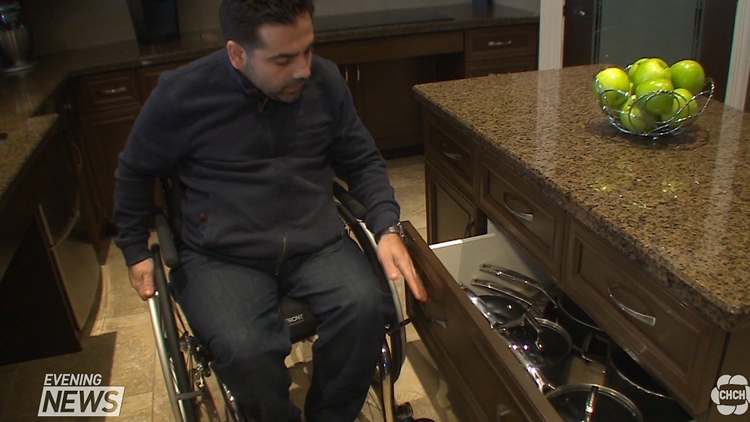Accessible Homes Are Letting People Be Independent
 2016-12-02
2016-12-02
After a devastating ATV accident, Domenic Cuda became paralyzed from the chest down. A husband and a father of two, he wanted to make sure he could remain independent for his family, but he still wanted to provide them with a beautiful and luxurious home, and with the help of a contactor and a friend he did just that.
Cuda can do virtually anything in his kitchen.
“If I have to grab a pot or pan, the pot and pan drawers are right here.”
Something as simple boiling water used to be a challenge, but now the whole house has been outfitted to fit all of his needs.
The accommodations aren’t that obvious.
“We didn’t want it to scream accessibility.”
Everything is low enough so Domenic can reach it, but not low enough so that it’s uncomfortable for his wife. He wanted her to have the home of her dreams.
“My wife is my angel. She’s stuck beside me from thick and thin and I owe everything to her.”
The stone ramp in the backyard wouldn’t look out of place at any home.
“Making a home as accessible as this one is — it’s actually less expensive to build a new one then it is to renovate a pre-existing one.”
“They are design elements as opposed to material elements.”
The most expensive element is the elevator, costing approximately $50 000.
Contractor Fred Losani says aside from the cost of the elevator, a similar home without the accessibility would only be around $10 000.
Next up is the development of an accessible community in Hamilton where people in wheelchairs can access parks and trails from their homes.
Categories
Archives
- November 2024
- May 2023
- May 2022
- March 2021
- January 2021
- August 2020
- April 2019
- March 2019
- November 2018
- June 2018
- April 2018
- March 2018
- February 2018
- January 2018
- November 2017
- October 2017
- September 2017
- August 2017
- July 2017
- June 2017
- May 2017
- April 2017
- March 2017
- February 2017
- January 2017
- December 2016
- November 2016
- October 2016
- September 2016
- August 2016
- July 2016
- June 2016
- May 2016
- April 2016
- March 2016
- November 2015
- October 2015
- September 2015
- August 2015
- July 2015
- June 2015
- April 2015
- February 2015
- December 2014
- October 2014
- July 2014
- October 2013
- September 2013
- June 2013
- May 2013
- March 2013
- February 2013
- April 2006
- November 2002
